TOYOTA GR YARIS 2023 Owners Manual
Manufacturer: TOYOTA, Model Year: 2023, Model line: GR YARIS, Model: TOYOTA GR YARIS 2023Pages: 470, PDF Size: 113.17 MB
Page 331 of 470
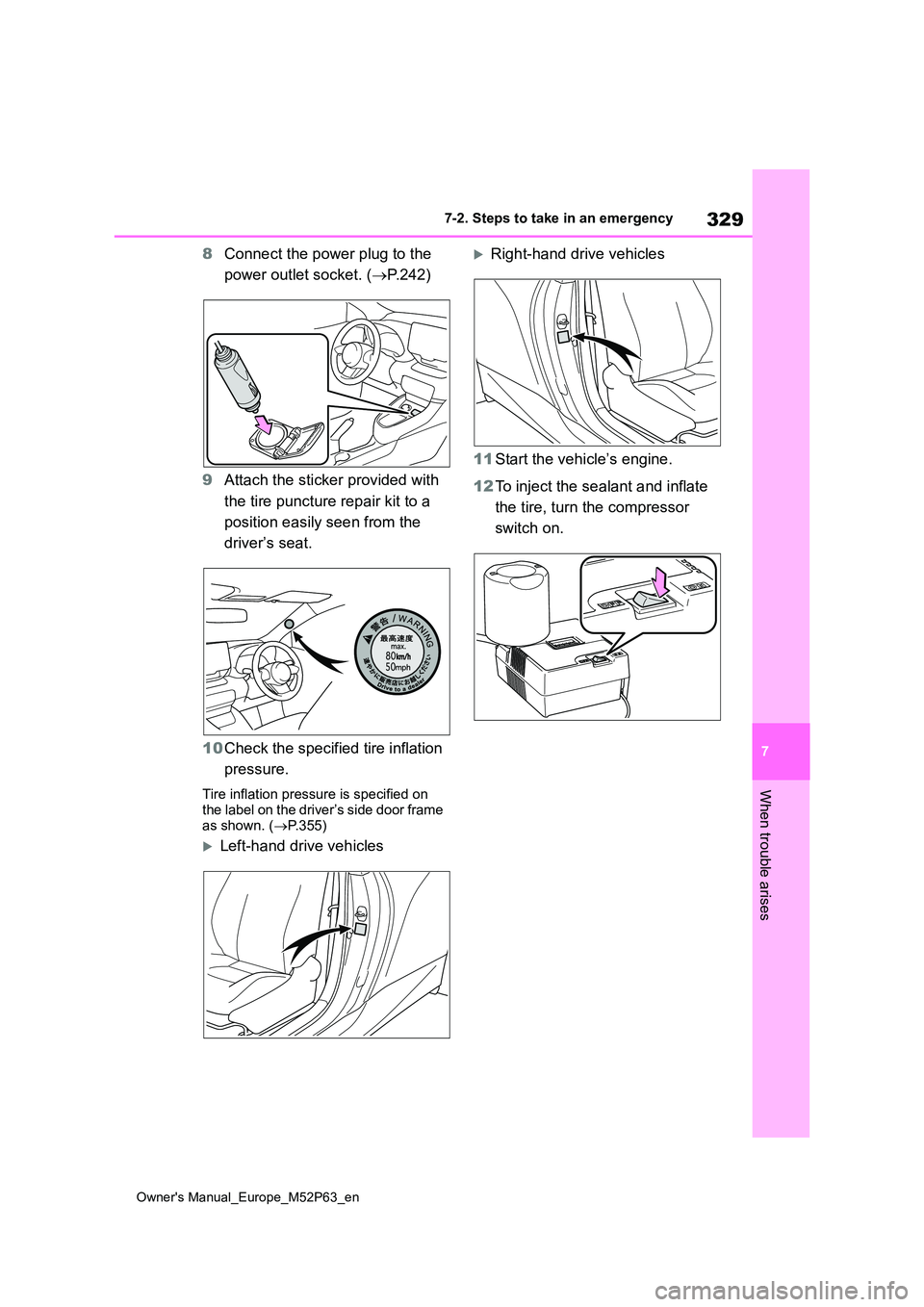
329
7
Owner's Manual_Europe_M52P63_en
7-2. Steps to take in an emergency
When trouble arises
8Connect the power plug to the
power outlet socket. ( P.242)
9 Attach the sticker provided with
the tire puncture repair kit to a
position easily seen from the
driver’s seat.
10 Check the specified tire inflation
pressure.
Tire inflation pressure is specified on the label on the driver’s side door frame
as shown. ( P.355)
Left-hand drive vehicles
Right-hand drive vehicles
11 Start the vehicle’s engine.
12 To inject the sealant and inflate
the tire, turn the compressor
switch on.
Page 332 of 470
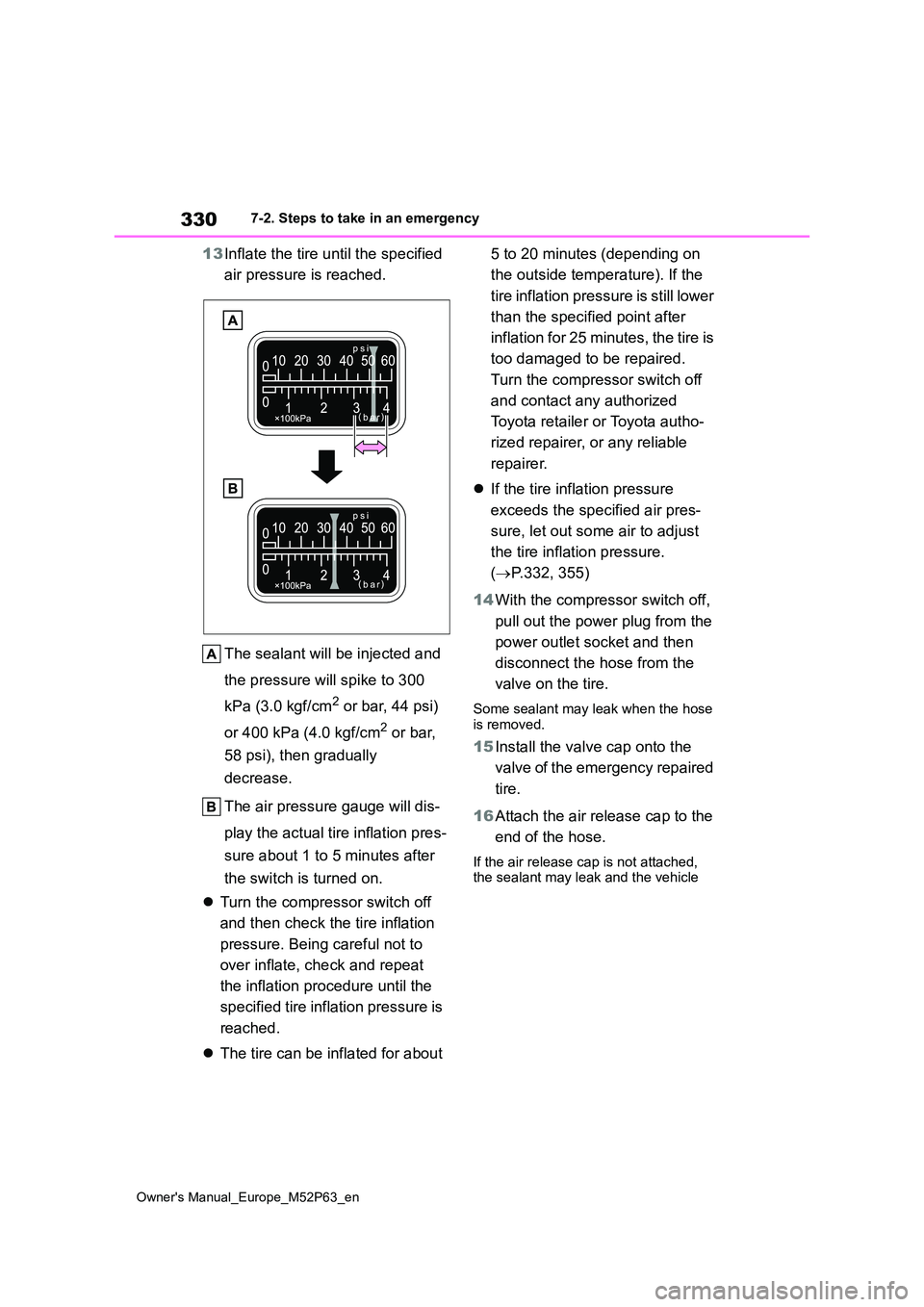
330
Owner's Manual_Europe_M52P63_en
7-2. Steps to take in an emergency
13Inflate the tire until the specified
air pressure is reached.
The sealant will be injected and
the pressure will spike to 300
kPa (3.0 kgf/cm2 or bar, 44 psi)
or 400 kPa (4.0 kgf/cm2 or bar,
58 psi), then gradually
decrease.
The air pressure gauge will dis-
play the actual tire inflation pres-
sure about 1 to 5 minutes after
the switch is turned on.
Turn the compressor switch off
and then check the tire inflation
pressure. Being careful not to
over inflate, check and repeat
the inflation procedure until the
specified tire inflation pressure is
reached.
The tire can be inflated for about
5 to 20 minutes (depending on
the outside temperature). If the
tire inflation pressure is still lower
than the specified point after
inflation for 25 minutes, the tire is
too damaged to be repaired.
Turn the compressor switch off
and contact any authorized
Toyota retailer or Toyota autho-
rized repairer, or any reliable
repairer.
If the tire inflation pressure
exceeds the specified air pres-
sure, let out some air to adjust
the tire inflation pressure.
( P.332, 355)
14 With the compressor switch off,
pull out the power plug from the
power outlet socket and then
disconnect the hose from the
valve on the tire.
Some sealant may leak when the hose is removed.
15 Install the valve cap onto the
valve of the emergency repaired
tire.
16 Attach the air release cap to the
end of the hose.
If the air release cap is not attached, the sealant may leak and the vehicle
Page 333 of 470
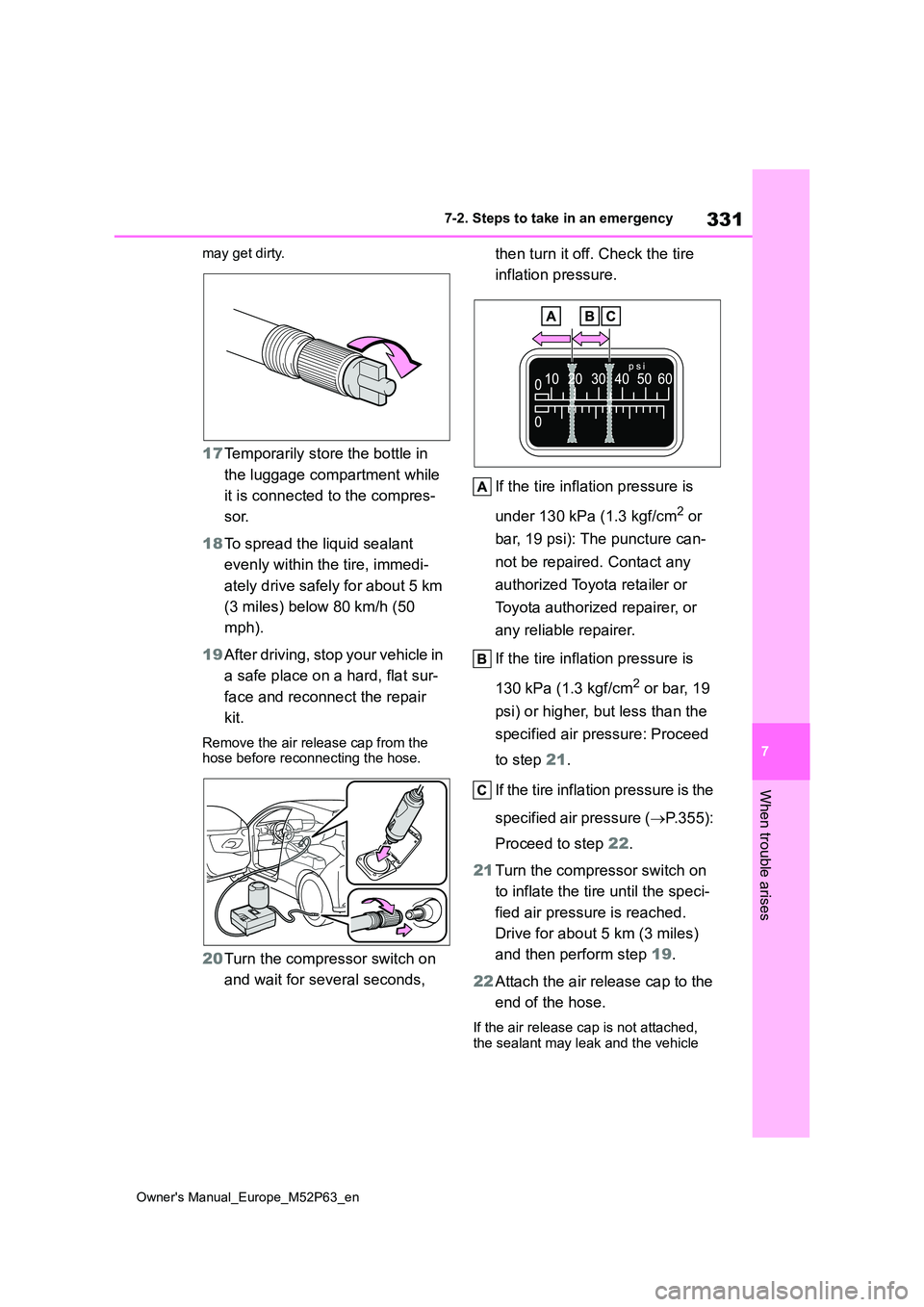
331
7
Owner's Manual_Europe_M52P63_en
7-2. Steps to take in an emergency
When trouble arises
may get dirty.
17Temporarily store the bottle in
the luggage compartment while
it is connected to the compres-
sor.
18 To spread the liquid sealant
evenly within the tire, immedi-
ately drive safely for about 5 km
(3 miles) below 80 km/h (50
mph).
19 After driving, stop your vehicle in
a safe place on a hard, flat sur-
face and reconnect the repair
kit.
Remove the air release cap from the hose before reconnecting the hose.
20 Turn the compressor switch on
and wait for several seconds,
then turn it off. Check the tire
inflation pressure.
If the tire inflation pressure is
under 130 kPa (1.3 kgf/cm2 or
bar, 19 psi): The puncture can-
not be repaired. Contact any
authorized Toyota retailer or
Toyota authorized repairer, or
any reliable repairer.
If the tire inflation pressure is
130 kPa (1.3 kgf/cm2 or bar, 19
psi) or higher, but less than the
specified air pressure: Proceed
to step 21.
If the tire inflation pressure is the
specified air pressure ( P.355):
Proceed to step 22.
21 Turn the compressor switch on
to inflate the tire until the speci-
fied air pressure is reached.
Drive for about 5 km (3 miles)
and then perform step 19.
22 Attach the air release cap to the
end of the hose.
If the air release cap is not attached, the sealant may leak and the vehicle
Page 334 of 470
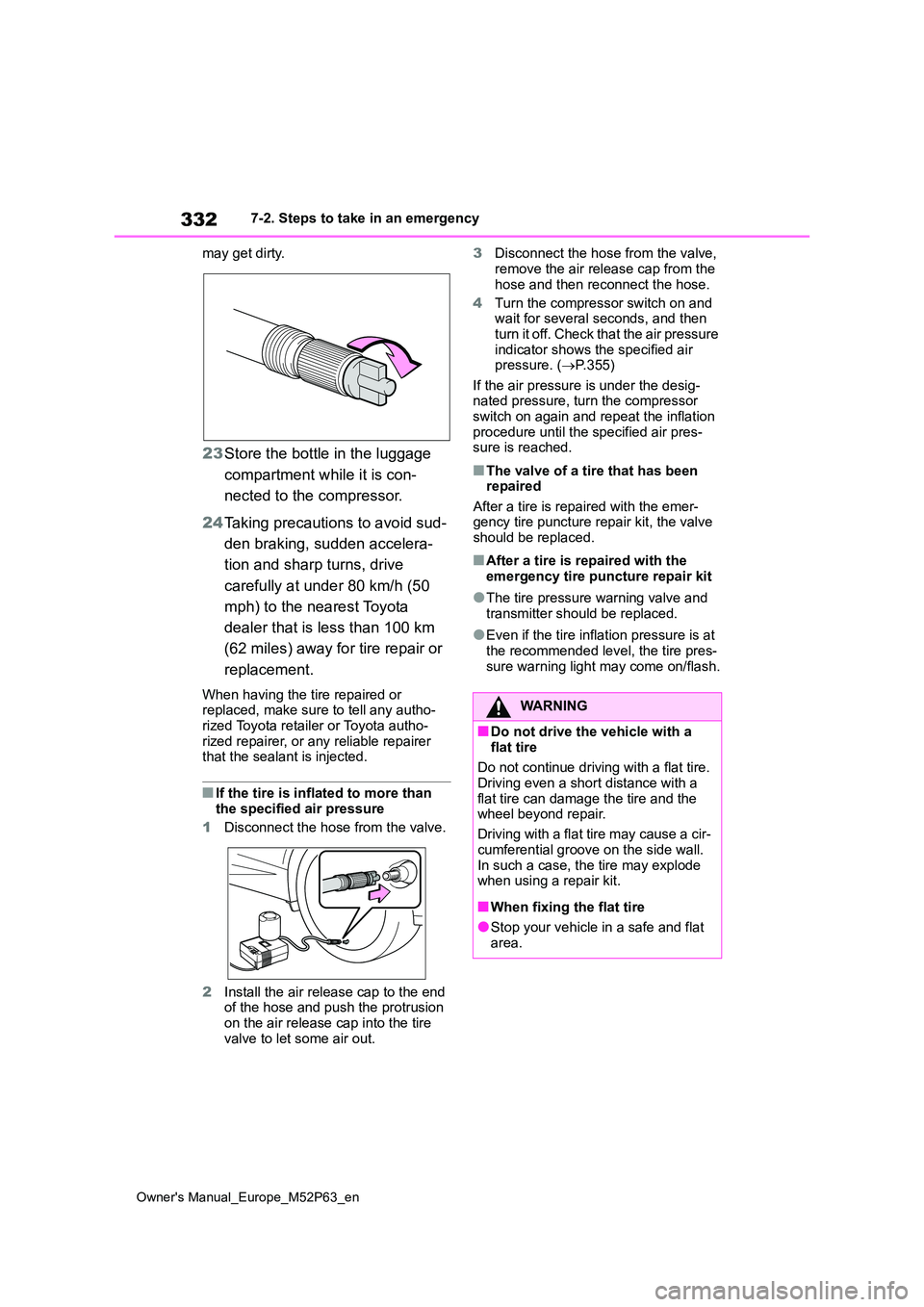
332
Owner's Manual_Europe_M52P63_en
7-2. Steps to take in an emergency
may get dirty.
23 Store the bottle in the luggage
compartment while it is con-
nected to the compressor.
24 Taking precautions to avoid sud-
den braking, sudden accelera-
tion and sharp turns, drive
carefully at under 80 km/h (50
mph) to the nearest Toyota
dealer that is less than 100 km
(62 miles) away for tire repair or
replacement.
When having the tire repaired or replaced, make sure to tell any autho-rized Toyota retailer or Toyota autho-
rized repairer, or any reliable repairer that the sealant is injected.
■If the tire is inflated to more than the specified air pressure
1 Disconnect the hose from the valve.
2 Install the air release cap to the end of the hose and push the protrusion
on the air release cap into the tire valve to let some air out.
3 Disconnect the hose from the valve,
remove the air release cap from the hose and then reconnect the hose.
4 Turn the compressor switch on and wait for several seconds, and then
turn it off. Check that the air pressure indicator shows the specified air pressure. ( P.355)
If the air pressure is under the desig- nated pressure, turn the compressor switch on again and repeat the inflation
procedure until the specified air pres- sure is reached.
■The valve of a tire that has been repaired
After a tire is repaired with the emer- gency tire puncture repair kit, the valve should be replaced.
■After a tire is repaired with the
emergency tire puncture repair kit
●The tire pressure warning valve and
transmitter should be replaced.
●Even if the tire inflation pressure is at
the recommended level, the tire pres- sure warning light may come on/flash.
WARNING
■Do not drive the vehicle with a
flat tire
Do not continue driving with a flat tire. Driving even a short distance with a
flat tire can damage the tire and the wheel beyond repair.
Driving with a flat tire may cause a cir-
cumferential groove on the side wall. In such a case, the tire may explode when using a repair kit.
■When fixing the flat tire
●Stop your vehicle in a safe and flat
area.
Page 335 of 470
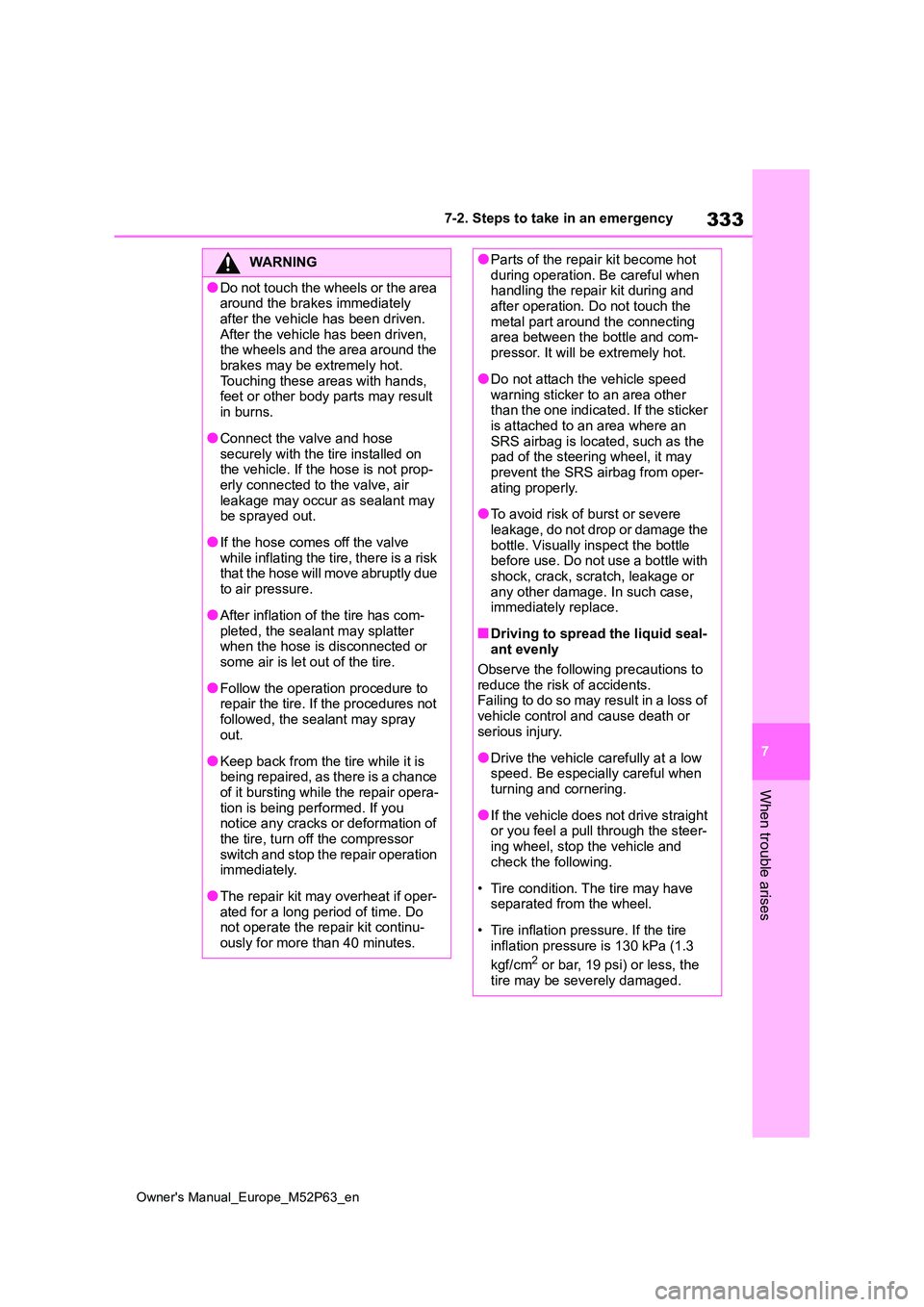
333
7
Owner's Manual_Europe_M52P63_en
7-2. Steps to take in an emergency
When trouble arises
WARNING
●Do not touch the wheels or the area around the brakes immediately
after the vehicle has been driven. After the vehicle has been driven, the wheels and the area around the
brakes may be extremely hot. Touching these areas with hands, feet or other body parts may result
in burns.
●Connect the valve and hose
securely with the tire installed on the vehicle. If the hose is not prop-erly connected to the valve, air
leakage may occur as sealant may be sprayed out.
●If the hose comes off the valve while inflating the tire, there is a risk that the hose will move abruptly due
to air pressure.
●After inflation of the tire has com-
pleted, the sealant may splatter when the hose is disconnected or some air is let out of the tire.
●Follow the operation procedure to repair the tire. If the procedures not
followed, the sealant may spray out.
●Keep back from the tire while it is being repaired, as there is a chance of it bursting while the repair opera-
tion is being performed. If you notice any cracks or deformation of the tire, turn off the compressor
switch and stop the repair operation immediately.
●The repair kit may overheat if oper-ated for a long period of time. Do not operate the repair kit continu-
ously for more than 40 minutes.
●Parts of the repair kit become hot during operation. Be careful when handling the repair kit during and
after operation. Do not touch the metal part around the connecting area between the bottle and com-
pressor. It will be extremely hot.
●Do not attach the vehicle speed
warning sticker to an area other than the one indicated. If the sticker is attached to an area where an
SRS airbag is located, such as the pad of the steering wheel, it may prevent the SRS airbag from oper-
ating properly.
●To avoid risk of burst or severe
leakage, do not drop or damage the bottle. Visually inspect the bottle before use. Do not use a bottle with
shock, crack, scratch, leakage or any other damage. In such case, immediately replace.
■Driving to spread the liquid seal-ant evenly
Observe the following precautions to reduce the risk of accidents.Failing to do so may result in a loss of
vehicle control and cause death or serious injury.
●Drive the vehicle carefully at a low speed. Be especially careful when turning and cornering.
●If the vehicle does not drive straight or you feel a pull through the steer-
ing wheel, stop the vehicle and check the following.
• Tire condition. The tire may have separated from the wheel.
• Tire inflation pressure. If the tire inflation pressure is 130 kPa (1.3
kgf/cm2 or bar, 19 psi) or less, the
tire may be severely damaged.
Page 336 of 470
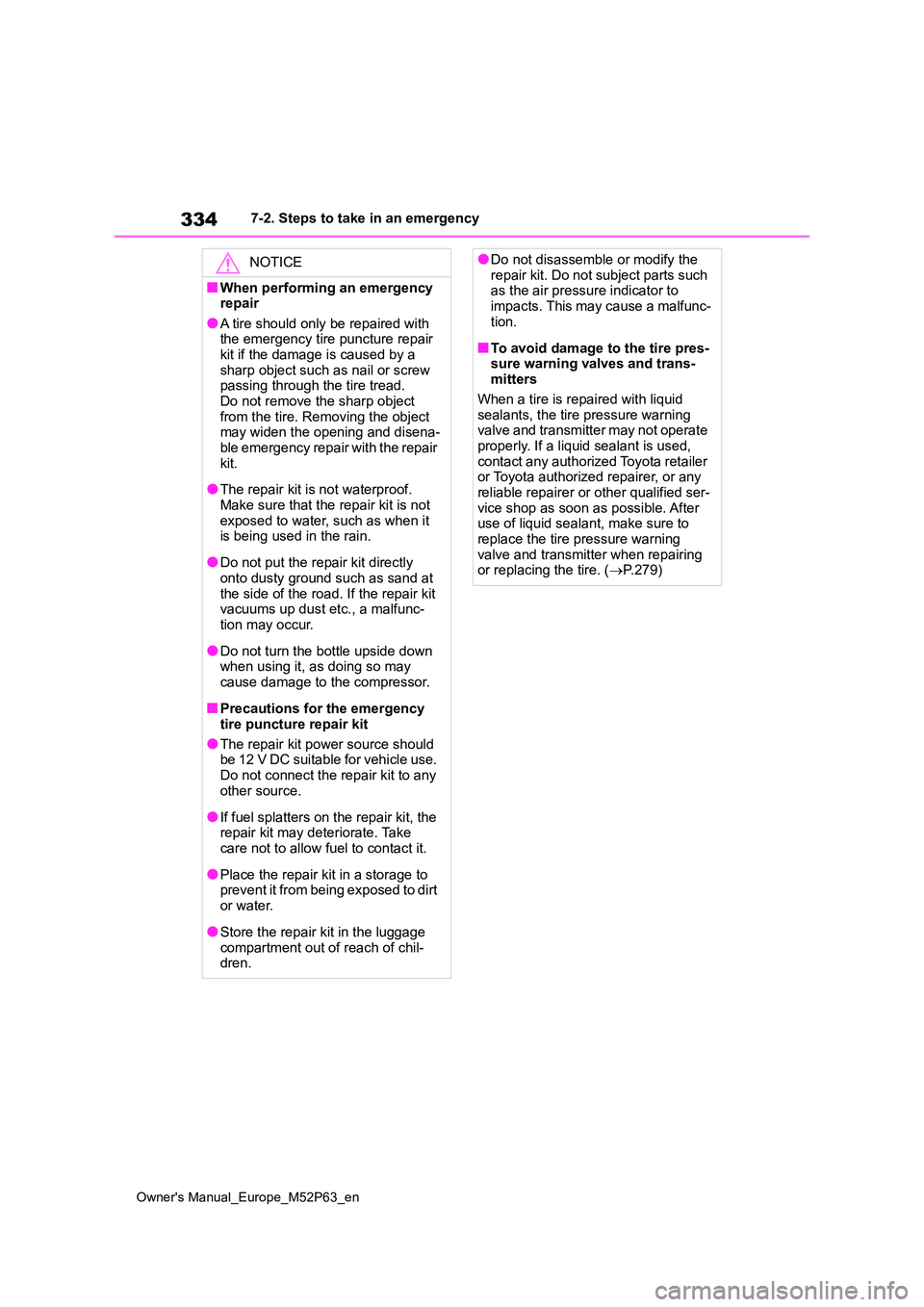
334
Owner's Manual_Europe_M52P63_en
7-2. Steps to take in an emergency
NOTICE
■When performing an emergency repair
●A tire should only be repaired with the emergency tire puncture repair kit if the damage is caused by a
sharp object such as nail or screw passing through the tire tread.Do not remove the sharp object
from the tire. Removing the object may widen the opening and disena-ble emergency repair with the repair
kit.
●The repair kit is not waterproof.
Make sure that the repair kit is not exposed to water, such as when it is being used in the rain.
●Do not put the repair kit directly onto dusty ground such as sand at
the side of the road. If the repair kit vacuums up dust etc., a malfunc-tion may occur.
●Do not turn the bottle upside down when using it, as doing so may
cause damage to the compressor.
■Precautions for the emergency
tire puncture repair kit
●The repair kit power source should be 12 V DC suitable for vehicle use.
Do not connect the repair kit to any other source.
●If fuel splatters on the repair kit, the repair kit may deteriorate. Take care not to allow fuel to contact it.
●Place the repair kit in a storage to prevent it from being exposed to dirt
or water.
●Store the repair kit in the luggage
compartment out of reach of chil- dren.
●Do not disassemble or modify the repair kit. Do not subject parts such as the air pressure indicator to
impacts. This may cause a malfunc- tion.
■To avoid damage to the tire pres-sure warning valves and trans-mitters
When a tire is repaired with liquid sealants, the tire pressure warning valve and transmitter may not operate
properly. If a liquid sealant is used, contact any authorized Toyota retailer or Toyota authorized repairer, or any
reliable repairer or other qualified ser- vice shop as soon as possible. After use of liquid sealant, make sure to
replace the tire pressure warning valve and transmitter when repairing or replacing the tire. ( P.279)
Page 337 of 470
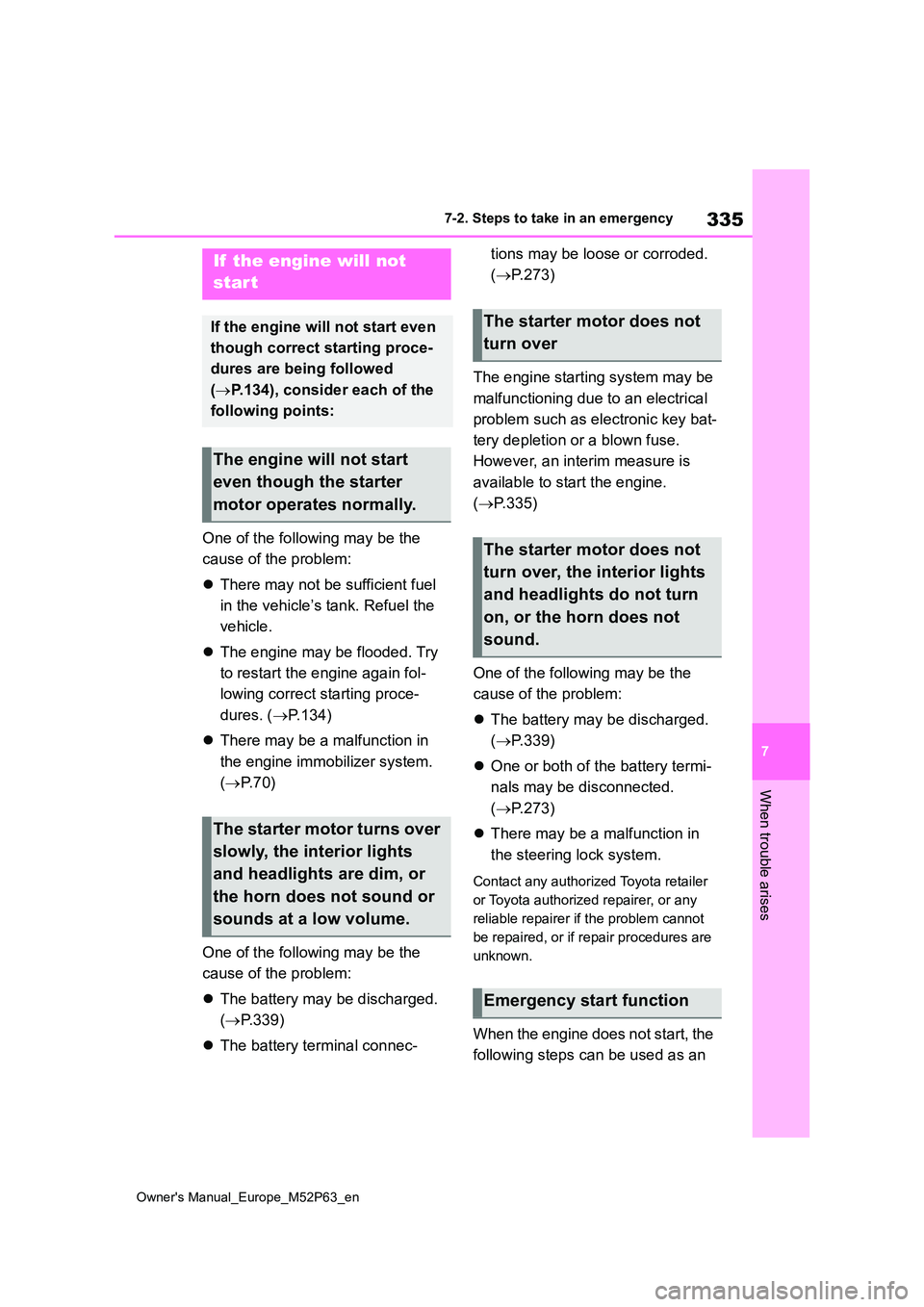
335
7
Owner's Manual_Europe_M52P63_en
7-2. Steps to take in an emergency
When trouble arises
One of the following may be the
cause of the problem:
There may not be sufficient fuel
in the vehicle’s tank. Refuel the
vehicle.
The engine may be flooded. Try
to restart the engine again fol-
lowing correct starting proce-
dures. ( P.134)
There may be a malfunction in
the engine immobilizer system.
( P. 7 0 )
One of the following may be the
cause of the problem:
The battery may be discharged.
( P.339)
The battery terminal connec-
tions may be loose or corroded.
( P.273)
The engine starting system may be
malfunctioning due to an electrical
problem such as electronic key bat-
tery depletion or a blown fuse.
However, an interim measure is
available to start the engine.
( P.335)
One of the following may be the
cause of the problem:
The battery may be discharged.
( P.339)
One or both of the battery termi-
nals may be disconnected.
( P.273)
There may be a malfunction in
the steering lock system.
Contact any authorized Toyota retailer
or Toyota authorized repairer, or any
reliable repairer if the problem cannot
be repaired, or if repair procedures are
unknown.
When the engine does not start, the
following steps can be used as an
If the engine will not
start
If the engine will not start even
though correct starting proce-
dures are being followed
( P.134), consider each of the
following points:
The engine will not start
even though the starter
motor operates normally.
The starter motor turns over
slowly, the interior lights
and headlights are dim, or
the horn does not sound or
sounds at a low volume.
The starter motor does not
turn over
The starter motor does not
turn over, the interior lights
and headlights do not turn
on, or the horn does not
sound.
Emergency start function
Page 338 of 470
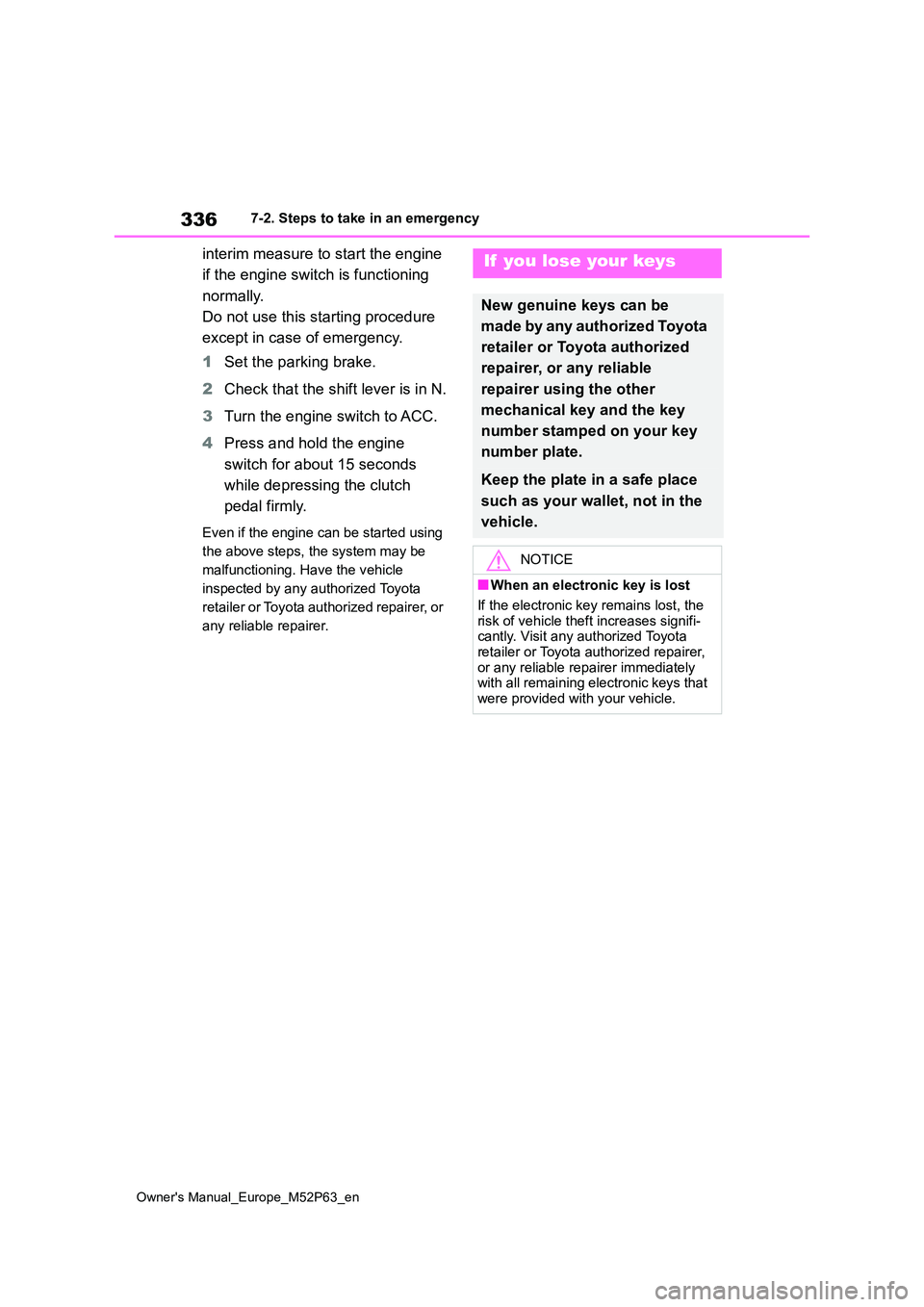
336
Owner's Manual_Europe_M52P63_en
7-2. Steps to take in an emergency
interim measure to start the engine
if the engine switch is functioning
normally.
Do not use this starting procedure
except in case of emergency.
1 Set the parking brake.
2 Check that the shift lever is in N.
3 Turn the engine switch to ACC.
4 Press and hold the engine
switch for about 15 seconds
while depressing the clutch
pedal firmly.
Even if the engine can be started using
the above steps, the system may be
malfunctioning. Have the vehicle
inspected by any authorized Toyota
retailer or Toyota authorized repairer, or
any reliable repairer.
If you lose your keys
New genuine keys can be
made by any authorized Toyota
retailer or Toyota authorized
repairer, or any reliable
repairer using the other
mechanical key and the key
number stamped on your key
number plate.
Keep the plate in a safe place
such as your wallet, not in the
vehicle.
NOTICE
■When an electronic key is lost
If the electronic key remains lost, the
risk of vehicle theft increases signifi- cantly. Visit any authorized Toyota retailer or Toyota authorized repairer,
or any reliable repairer immediately with all remaining electronic keys that were provided with your vehicle.
Page 339 of 470
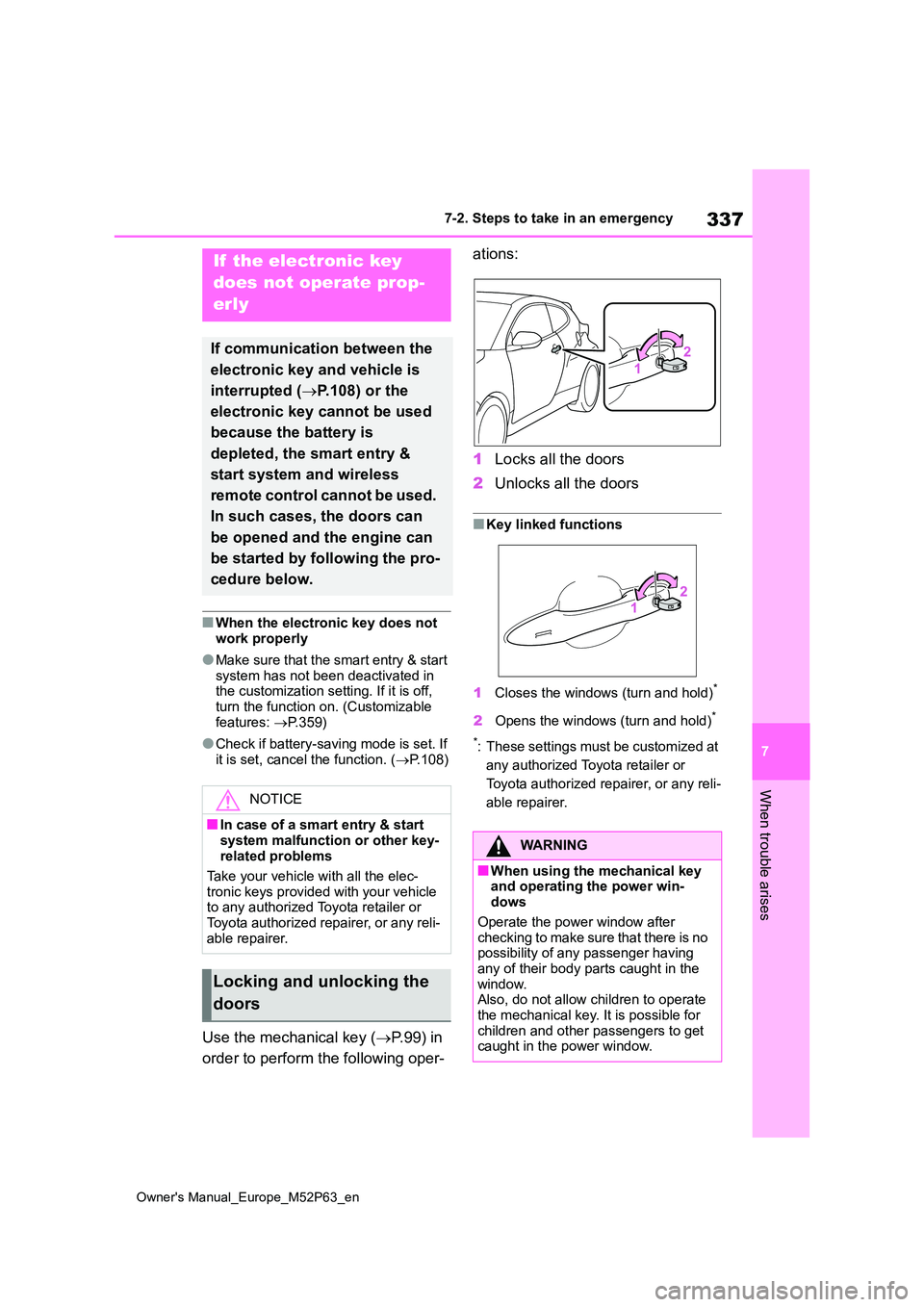
337
7
Owner's Manual_Europe_M52P63_en
7-2. Steps to take in an emergency
When trouble arises
■When the electronic key does not work properly
●Make sure that the smart entry & start system has not been deactivated in the customization setting. If it is off,
turn the function on. (Customizable features: P.359)
●Check if battery-saving mode is set. If it is set, cancel the function. ( P.108)
Use the mechanical key (P.99) in
order to perform the following oper-
ations:
1 Locks all the doors
2 Unlocks all the doors
■Key linked functions
1 Closes the windows (turn and hold)*
2Opens the windows (turn and hold)*
*: These settings must be customized at
any authorized Toyota retailer or
Toyota authorized repairer, or any reli-
able repairer.
If the electronic key
does not operate prop-
erly
If communication between the
electronic key and vehicle is
interrupted ( P.108) or the
electronic key cannot be used
because the battery is
depleted, the smart entry &
start system and wireless
remote control cannot be used.
In such cases, the doors can
be opened and the engine can
be started by following the pro-
cedure below.
NOTICE
■In case of a smart entry & start
system malfunction or other key- related problems
Take your vehicle with all the elec-
tronic keys provided with your vehicle to any authorized Toyota retailer or Toyota authorized repairer, or any reli-
able repairer.
Locking and unlocking the
doors
WARNING
■When using the mechanical key and operating the power win-dows
Operate the power window after checking to make sure that there is no possibility of any passenger having
any of their body parts caught in the window.Also, do not allow children to operate
the mechanical key. It is possible for children and other passengers to get caught in the power window.
Page 340 of 470
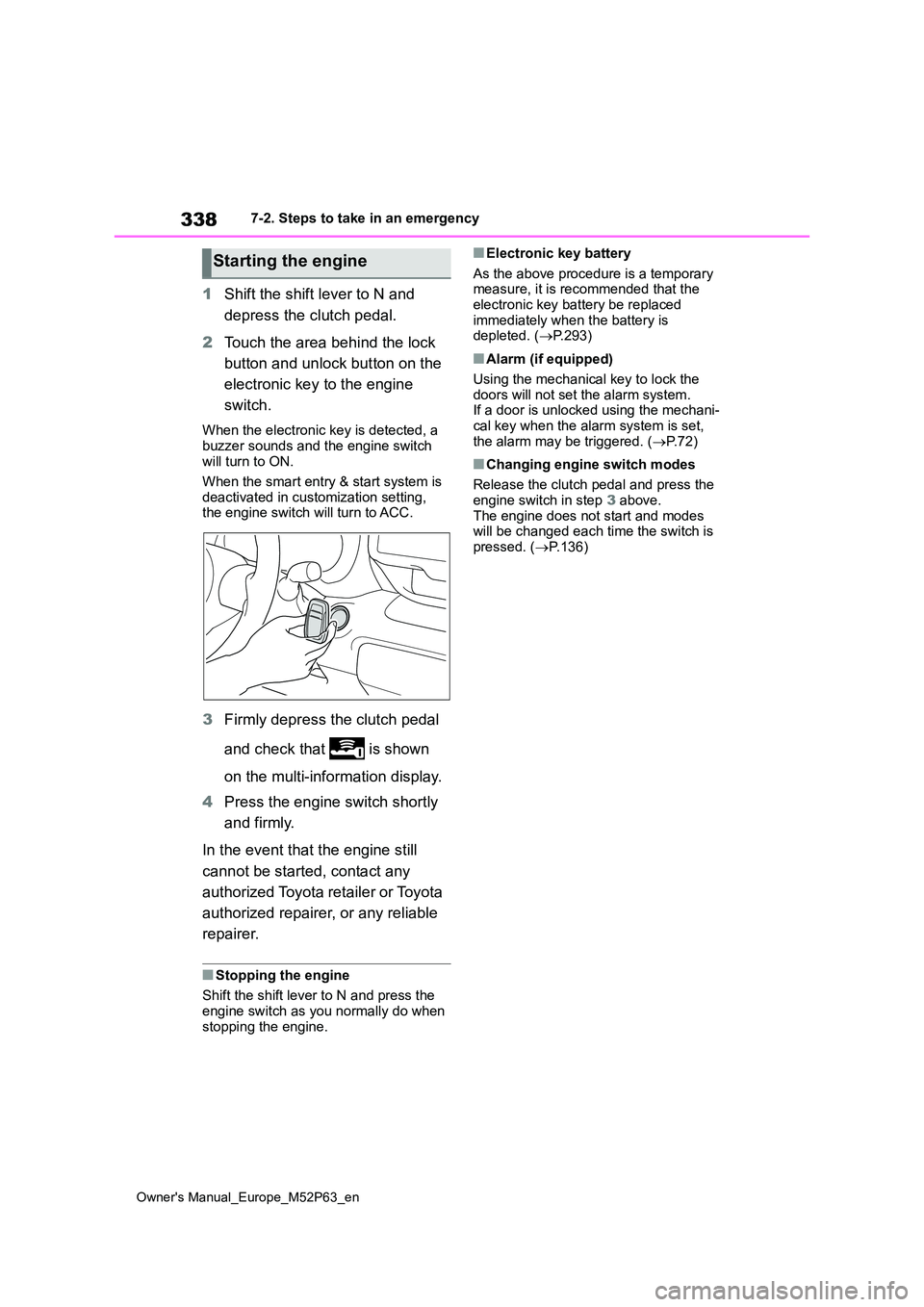
338
Owner's Manual_Europe_M52P63_en
7-2. Steps to take in an emergency
1Shift the shift lever to N and
depress the clutch pedal.
2 Touch the area behind the lock
button and unlock button on the
electronic key to the engine
switch.
When the electronic key is detected, a
buzzer sounds and the engine switch will turn to ON.
When the smart entry & start system is
deactivated in customization setting, the engine switch will turn to ACC.
3 Firmly depress the clutch pedal
and check that is shown
on the multi-information display.
4 Press the engine switch shortly
and firmly.
In the event that the engine still
cannot be started, contact any
authorized Toyota retailer or Toyota
authorized repairer, or any reliable
repairer.
■Stopping the engine
Shift the shift lever to N and press the engine switch as you normally do when
stopping the engine.
■Electronic key battery
As the above procedure is a temporary measure, it is recommended that the electronic key battery be replaced
immediately when the battery is depleted. ( P.293)
■Alarm (if equipped)
Using the mechanical key to lock the
doors will not set the alarm system. If a door is unlocked using the mechani-cal key when the alarm system is set,
the alarm may be triggered. ( P. 7 2 )
■Changing engine switch modes
Release the clutch pedal and press the engine switch in step 3 above.
The engine does not start and modes will be changed each time the switch is pressed. ( P.136)
Starting the engine